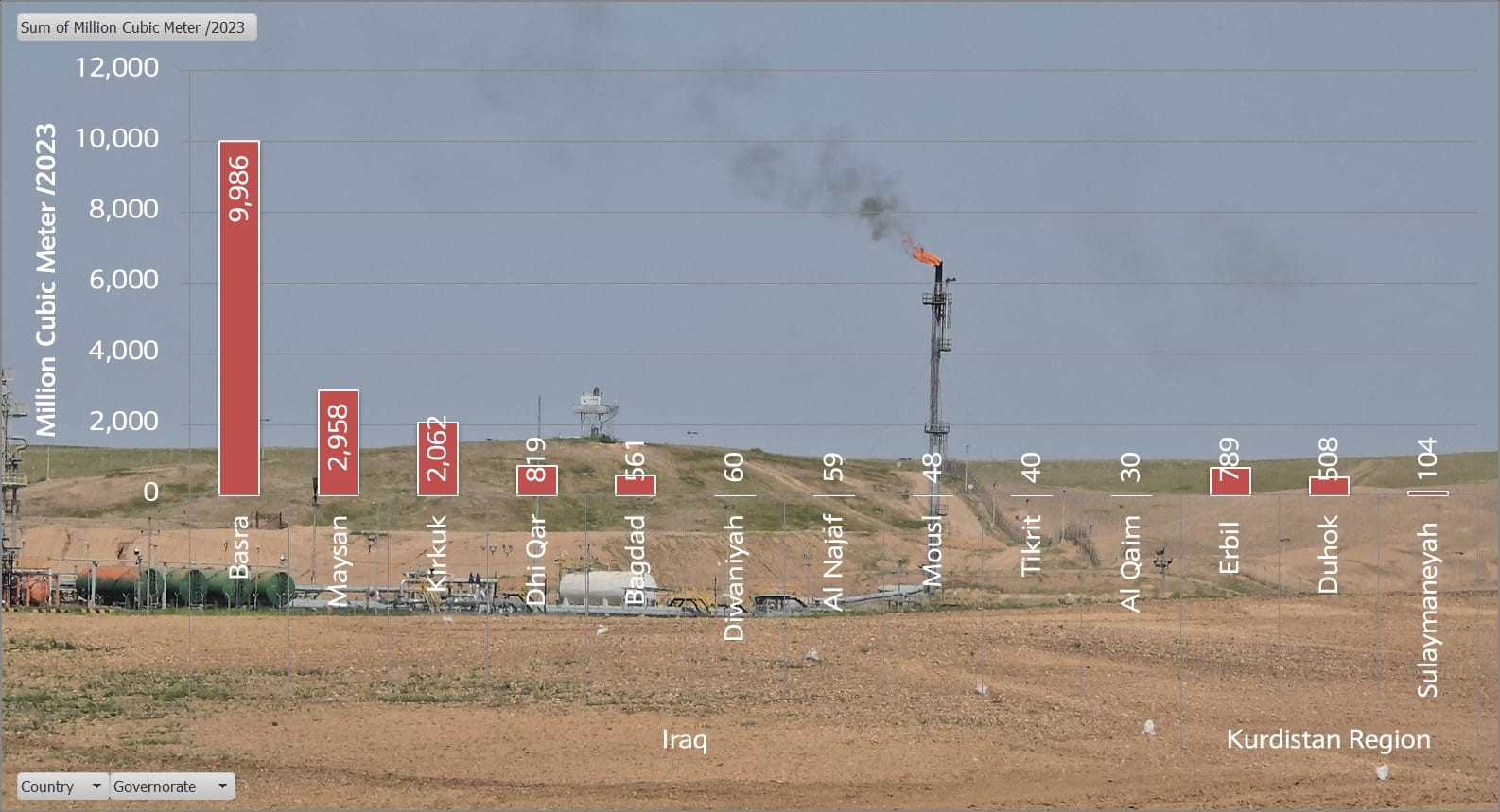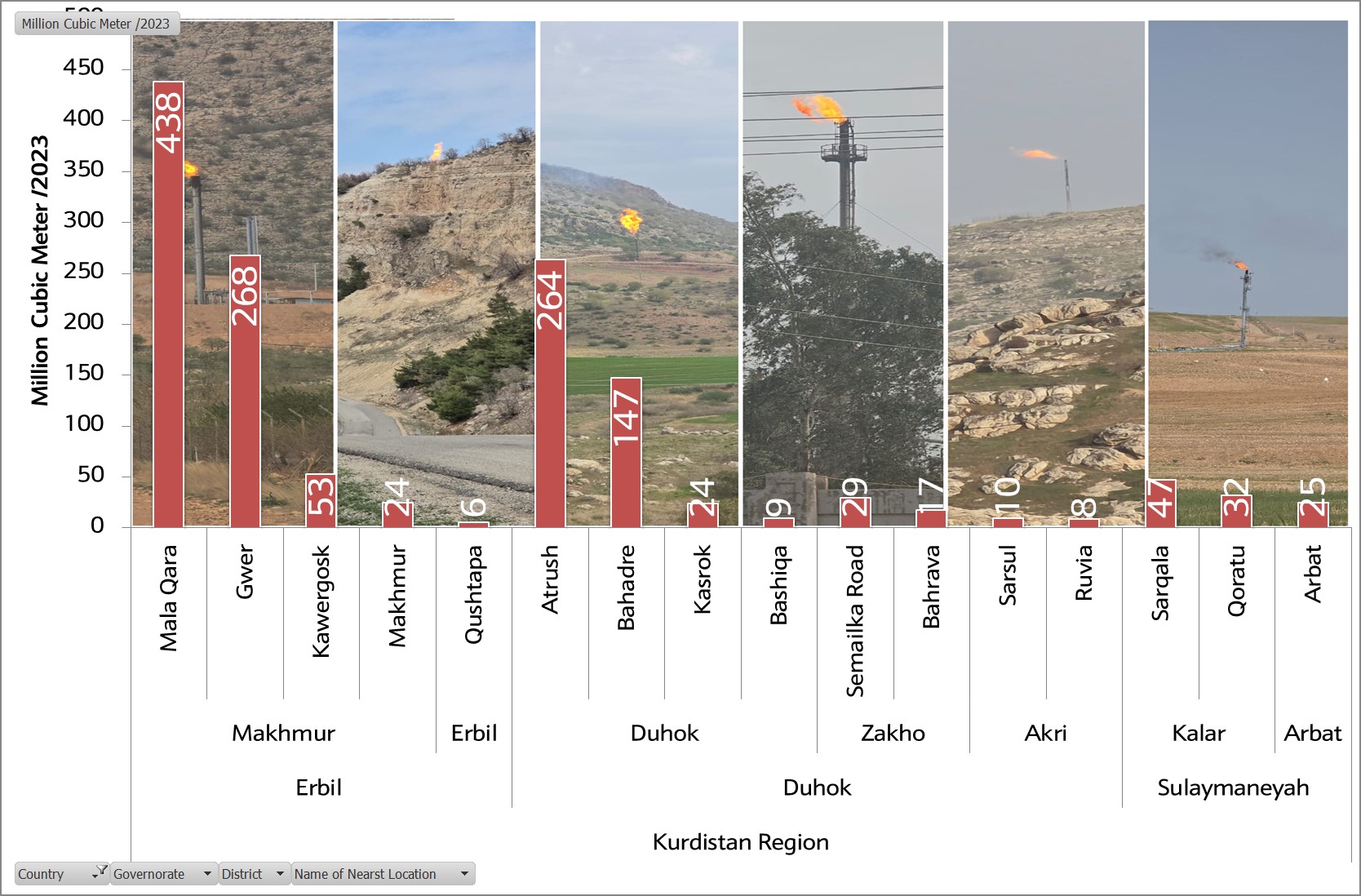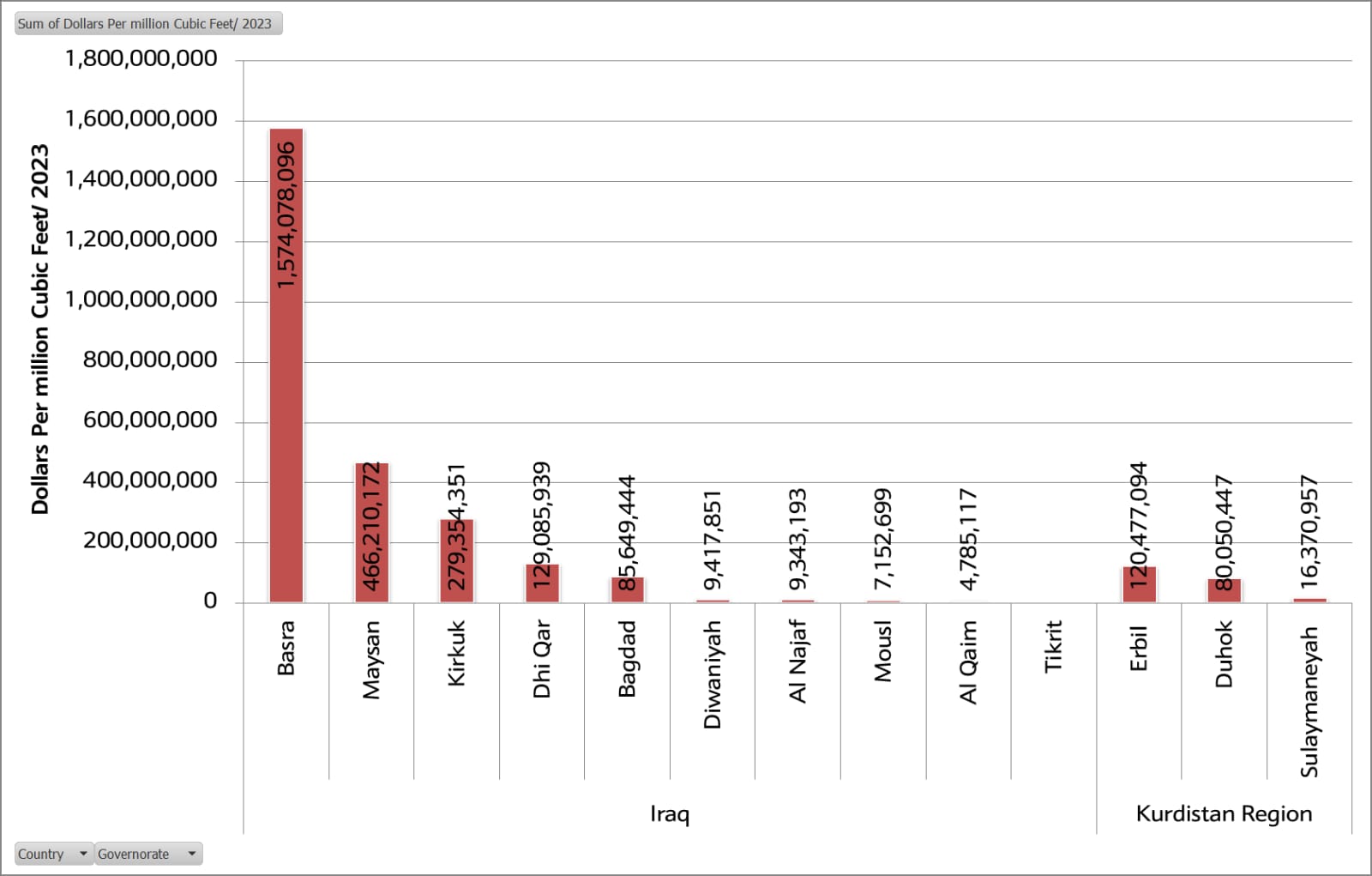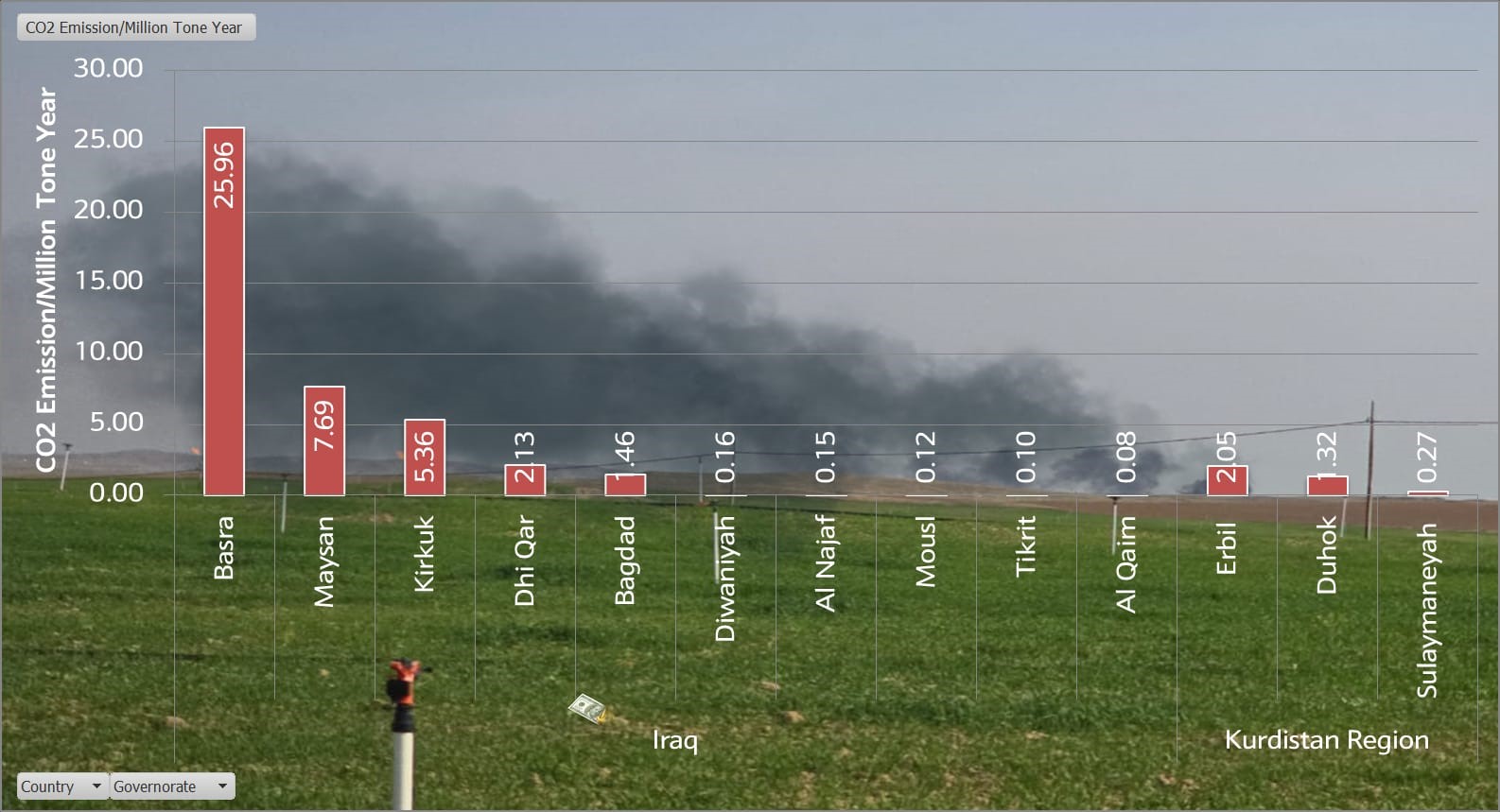In the past decade, the amount of associated gas flared in Iraq and the Kurdistan Region has increased by over 39 percent. Despite all efforts to reduce it, the latest report by the World Bank and Sky Truth on global gas flaring indicate that the amount still exceeds 18.02 billion cubic meters per year.
In 2023, 214 oil production fields and oil refinery locations were identified across Iraq and the Kurdistan Region as having high-temperature and carbon dioxide emission density levels resulting from the burning of associated gas in these locations. Data accumulated from field visits to sites located in the Kurdistan Region revealed that the amounts recorded reflect the intensity and density of the flames from the pipes used to burn the gas.
Despite the efforts exerted by both the Federal Government of Iraq and the Kurdistan Regional Government to reduce the amount of associated gas flaring from oil fields, the Iraqi Ministry of Oil says it wants to invest in 70 percent of the amount of gas burned annually. However, despite all the contracts signed and the investments of previous years, more than 30 percent of the gas is still being flared.
The financial losses due to gas flaring in Iraq and the Kurdistan Region amount to over $2.7 billion annually, with Basra province alone accounting for $1.5 billion, followed by Maysan and Kirkuk.
At the level of the Kurdistan Region’s provinces, the amount of money wasted annually due to associated gas flaring in Erbil alone exceeds $120 million.
Another aspect of associated gas flaring is the emission of carbon dioxide or greenhouse gas. The latter is identified as black carbon and is considered one of the main contributors to global warming and increased air pollution.
Out of approximately 350 million tons of carbon dioxide released into the air annually due to associated gas flaring, 46 million tons came from Iraq. This means that one-seventh of carbon dioxide emissions that originate from gas flaring come from Iraq and the Kurdistan Region.
Latest global rankings of associated gas flaring: Iraq’s position
Between 2013 and 2022, Iraq ranked second globally for associated gas flaring from oil production and crude oil refineries. However, data from the Central Bank of Iraq (CBI) showed that in 2023 Iran surpassed Iraq, taking second place with 20.4 billion cubic meters of flared gas, while Iraq dropped to third with 18.02 billion cubic meters.
The CBI data further showed that while Iraq in 2013 burned 13.3 billion cubic meters of associated gas, a decade later, the amount of flared has reached 17.6 billion cubic meters in 2023, just from oil production.
The increase is proportionate to the increase in Iraq’s oil production, as 75 percent of Iraq's flared gas comes in the form of associated gas and not free gas. Therefore, any plan to increase oil production - which Iraq says it intends to do, raising its output to 7 million barrels per day - also means increasing the amount of associated gas flaring, if new methods are not adopted.
Annual gas flaring volumes in Iraq and the Kurdistan Region
Each year, associated gas is flared in varying amounts across the provinces of Iraq and the Kurdistan Region. As shown in the first graphic, Basra province flared 9.9 billion cubic meters, in Maysan province 2.9 billion cubic meters, and in Kirkuk 2 billion cubic meters in 2023.
In the Kurdistan Region level, the amount of gas flared in 2023 stood at 1.4 billion cubic meters, with 789 million cubic meters burned in Erbil, 508 million cubic meters in Dohuk, and 104 million cubic meters in Sulaimani.
Although various agreements and projects have been implemented to reduce the trend of associated gas burning, the rise in oil production has contributed to an increase in gas flaring. In 2013, the amount of oil produced was 3.99 million barrels per day, and associated gas flaring increased to 13.3 billion cubic meters. However, when oil production reached 4.3 million barrels of oil per day in 2023, the associated gas flaring also rose to 18.02 billion cubic meters.
During his participation at the Erbil Forum 2025, the Iraqi Deputy Minister of Oil for Gas Affairs stated, "In the past decade, the amount of associated gas that has not been flared and has been successfully invested in increased by 9 percent from 2021 to 2023." This means that in 2021, out of a total of 83.98 million cubic meters per day, 44.17 million cubic meters per day were utilized, while the rest was flared.
However, in 2023, out of a total of 88.38 million cubic meters per day, 54.79 million cubic meters per day were utilized, and the amount flared and wasted has decreased.
However, data from the World Bank and other sources like Sky Truth show that the reduction in associated gas flaring has not been as significant as stated, with only a 1 percent reduction during this period.
There are 45 locations in the Kurdistan Region where associated gas is flared daily. Nearly half of these sites, 22, are in Erbil, with 20 in Duhok and 3 in Sulaimani.
The total amount of gas burned annually reaches 1.4 billion cubic meters. In Erbil province, the highest amount of flared gas is recorded in Makhmour district and the Mala Qara and Gwer areas.
In Duhok province, the Atrush and Sarsang oil fields are the largest contributors, with 263 million cubic meters annually, followed by the Baadre oil field with 146 million cubic meters.
Meanwhile, in Sulaimani province, of the three locations where associated gas is flared, two are oil fields and one is a new oil refinery situated along the Arbat Road.
Since 2020, there has been an investment in the Sarqala oil field to reduce flaring. The associated gas produced with oil is used to operate a 165-megawatt power station, utilizing 1.13267 million cubic meters of associated gas per day, which reduces carbon dioxide emissions by 840 tons daily.
Additionally, oil production at the Chia Surkh oil field has been suspended for over a year, and associated gas flaring there has stopped. However, according to World Bank data, the amount flared in 2023 within Sulaimani province stood at 47.31 million cubic meters at the Sarqala oil field, and 24.5 million cubic meters at the Focus refinery, as shown in the graphic below.
Note 1: The images in this graphic show oil fields in the Kurdistan Region taken during March 18-19 and April 3, 2025.
Note 2: Among all the sites identified by satellite as locations of associated gas flaring, two fields with zero production, including the Erbil Oil Field and Chia Surkh, are completely shut down.
The financial and environmental costs of continued associated gas flaring
If we calculate the value of one thousand cubic meters of gas at industrial market prices, the annual financial losses from associated gas flaring in Iraq and the Kurdistan Region amount to $2.78 billion, with Iraq accounting for $2.56 billion and the Kurdistan Region accounting for $216 million.
Importantly, Iraq has not only suffered the loss of this amount. The Iraqi Deputy Minister of Oil for Gas Affairs stated at the Erbil Forum that "the damage caused by gas flaring is three times greater, because we have to import it at double the price, and the environmental damage goes beyond that."
Furthermore, if we analyze the total losses at the provincial level, in Basra they reach $4.3 million daily, and in Erbil they reach $342,000 daily. This flaring occurs while Basra suffers from a lack of basic services and Erbil is struggling with increasing levels of air pollution in the city.
Note 1: Here, the amount of flared associated gas is calculated at the price of US commercial gas for 2023, which is set at an average of $4.463 per 28.31 cubic meters.
Continuing the emission of 46 million tons of carbon dioxide in the era of climate change accelerates its manifestation, which Iraq is currently experiencing with increased dust storm days per year, decreased rainfall and increased annual drought cycles, reduction of river and stream water levels and the disappearance of stream and pond waters, increased desertification and decreased forests, and above all, the shortening of winter season duration and an increase in days where temperatures exceed 50 degrees Celsius.
In fact, a major reason why air quality in Iraq and the Kurdistan Region is considered among the worst in the world - ranking at 13th place in terms of daily air pollution, alongside countries such as Chad, Pakistan, and Rwanda - is due to carbon dioxide emissions. One-quarter of these annual emissions originates from associated gas flaring.
Generally, air pollution in Iraq and the Kurdistan Region is 8 times higher than the global standard. The World Health Organization notes that the concentration of polluting particles in the air should not exceed five micrograms per cubic meter; however, the concentration in Iraq has reached 74 micrograms per cubic meter.
According to a study by the Rice University and the Clean Air Task Force in Boston, in the USA, flaring associated gas from oil production causes the emission of black carbon, which is one of the main sources of health deterioration for residents nearby regions and contributes to climate warming in these regions.
Note 1: The image was taken on March 18, 2025, at one of the oil fields near Erbil.
Note 2: The amount of carbon dioxide emissions from associated gas flaring has been calculated according to the World Bank, where 1 cubic meter of flared associated gas equals the emission of 2.6 kilograms of carbon dioxide.
Ongoing Associated Gas Flaring and the Preparation of Gas Fields for Investment
According to data shared by the Iraqi Ministry of Oil at the Erbil Forum 2025, "Iraq has not invested in gas for four decades. Of a total of 3.60 trillion cubic meters of gas reserves, 2.76 trillion cubic meters exist as associated gas, but domestic needs have not been met."
The same data indicated that, "In June 2024, production levels reached 61.88 million cubic meters per day, with plans to reach 78.89 million cubic meters per day by the end of 2026, and if projects are implemented, to reach 173.08 million cubic meters per day by the end of 2036."
Also, last year Iraq burned 31.74 million cubic meters per day of associated gas, which represents 33 percent of the total associated gas produced from oil. Another point, according to data provided by the Iraqi Deputy Minister of Oil for Gas Affairs, the total investment that will be implemented by the end of 2026 will reach 16.99 million cubic meters per day, and by the end of 2036, the amount will be 94.89 million cubic meters per day. Of this increase, only 25.49 million cubic meters per day will come from oil fields, while the rest will come from gas fields.
Also, we should not overlook that the Kurdistan Region's approach regarding associated gas flaring and investment in gas fields is completely different from that of Iraq and even other countries in the region, because the Kurdistan Region has three successful examples of reducing associated gas flaring and investment in gas fields. All this is happening while out of a total of 10 gas fields and combined oil and gas fields in the Kurdistan Region, investment for gas production has only been made in four fields.
Another example of the Kurdistan Region's success in gas investment compared to Iraq is the Khor Mor and Chamchamal gas project, as it is planned to increase investment by 14.16 million cubic meters per day in the first quarter of 2026, while the total Iraqi projects in this sector that will come into being by the end of 2026 amount to 16.99 million cubic meters per day. One of the notable examples is the Norwegian company DNO's project to reduce associated gas flaring. According to statements from DNO company and the Flarelntel report, "Due to investment in associated gas at the Peshkabir field, they have been able to reduce gas flaring by 566 thousand cubic meters," which means reducing gas flaring from 849 thousand cubic meters to 283 thousand cubic meters and decreasing carbon dioxide emissions by 478 thousand tons per year.
Now, Iraq and even the Kurdistan Region are directing investment in this sector toward new fields rather than toward fields that are currently flaring associated gas. For example, in the fifth plus and sixth rounds, out of 27 fields prepared for investment, 11 were gas fields and five were joint "oil and gas" fields.
Also, in recent days, Dana Gas and Crescent Petroleum, which operate in the Kurdistan Region's gas sector, confirmed the same thing in a statement when they indicated that "their partners have approved $160 million for rapid exploration and initial development of the Chamchamal gas field, along with following up on further exploration programs to reveal higher levels of hydrocarbon in the Khor Mor field."
Conclusion
Should the burning of 18.02 billion cubic meters, the emission of 45 million tons of carbon dioxide, and the waste of $2.7 billion annually continue? This is mindful of the environmental damage caused that is known as black carbon emission, which accelerates and worsens the climate of Iraq and the Kurdistan Region.
Despite these damages, according to the latest assessment by the International Energy Agency (IEA), these climate changes will create significant obstacles for new energy projects in the future, especially solar system projects and the utilization of sunlight due to the anticipated increase in dust storm days.
Both the Federal Government of Iraq and the Kurdistan Regional Government have announced plans to end associated gas flaring in recent years.
The Iraqi Oil Minister on April 7, 2024 made an announcement urging ending associated gas flaring by 2028. For its part, the Kurdistan Regional Government notified companies to end the flaring of gas produced with oil since 2020. However, the amount still being burned remains concerning and should not be overlooked.
Finally, if reducing 300 thousand tons of carbon dioxide emissions equals reducing carbon dioxide emissions from 150 thousand automobiles as indicated by Norwegian company DNO, then ending associated gas flaring in Iraq and the Kurdistan Region would be equivalent to converting three times all the automobiles used daily on the roads of Iraq and the Kurdistan Region to electric vehicles with zero carbon dioxide emissions.













Comments
Rudaw moderates all comments submitted on our website. We welcome comments which are relevant to the article and encourage further discussion about the issues that matter to you. We also welcome constructive criticism about Rudaw.
To be approved for publication, however, your comments must meet our community guidelines.
We will not tolerate the following: profanity, threats, personal attacks, vulgarity, abuse (such as sexism, racism, homophobia or xenophobia), or commercial or personal promotion.
Comments that do not meet our guidelines will be rejected. Comments are not edited – they are either approved or rejected.
Post a comment